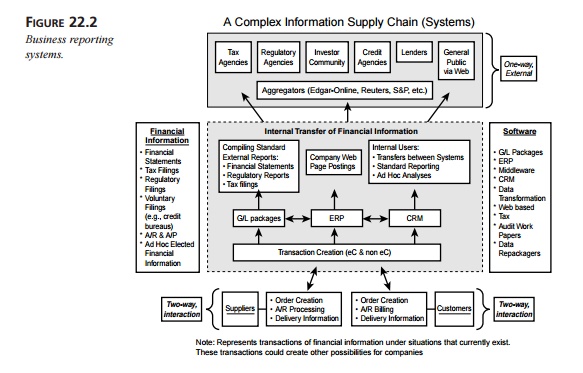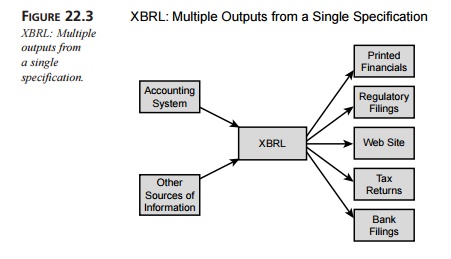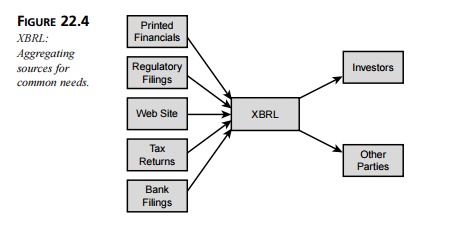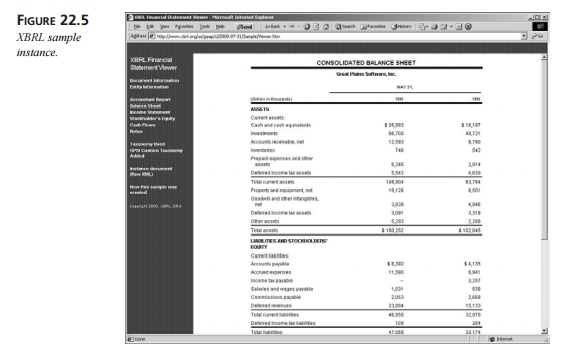Chapter: XML and Web Services : Applied XML : Applied XML in Vertical Industry
Finance and Accounting: The Extensible Business Reporting Language (XBRL)
Finance and Accounting
The finance industries of banking, accounting, securities trading,
research and reporting, and economics have always needed timely, accurate, and
critical access to information. As such, they have always been early
implementers of electronic document exchanges. Automatic Teller Machines (ATMs)
have implemented early forms of electronic com-merce since the late 1970s.
However, XML now allows for lower cost of delivery for this information;
therefore, both existing and new standards are being created for the delivery
of financial-related information. Of course, in this particular industry,
security and time-sensitiveness are the key issues that XML standards must
resolve.
The Extensible Business Reporting Language (XBRL)
One of the most important financial activities within a corporation is
the reporting of financial or business data. Reporting of financial data
happens throughout a business organization and even external to it. Business
units, divisions, entire corporations, sub-sidiaries, partners, regulatory
agencies, and the government all require financial reports of one sort or
another. The strong need for this sort of business reporting is met with an
equally strong challenge in the difficulty to share financial data across
disparate systems. Typically, many systems in an organization store financial
and related business informa-tion—accounting systems, supply-chain systems,
Customer Relationship Management (CRM), sales and marketing, Enterprise
Resource Planning (ERP), asset and inventory management, and human resources
systems are just a few such repositories of financial and business data. Figure
22.2 illustrates the complex universe of financial reporting sys-tems and
interactions. The challenge is therefore great to have all these systems
transmit their data in a common format that can then be aggregated for the
purpose of creating consolidated balance sheets, reports of income, financial
statements, financial informa-tion, nonfinancial information, regulatory
filings, such as annual and quarterly financial statements, and other data
necessary for the daily operation of the business and compli-ance with
regulations.
The Extensible Business Reporting Language (XBRL) solves this problem by
providing software vendors, programmers, and end users who adopt it a means to
enhance the cre-ation, exchange, and comparison of business reporting
information. The primary users of the XBRL specification are those responsible
for the preparation of financial informa-tion, intermediaries in those
preparation and distribution processes, end users of business report
information, as well as vendors who supply software and services to the
previous user types. The overall intention is to balance the needs of these
groups, creating a prod-uct that provides benefits to all groups. Although XBRL
represents a new methodology for data information exchange, its goal is to
facilitate current business reporting practice, not to change or set new
accounting standards. The general goals of the format can be seen in Figure
22.3 and Figure 22.4.


XBRL provides users with a standard format in which to prepare,
exchange, extract, and compare financial reports that can be subsequently
presented in a variety of ways. The specification also facilitates the ability
to “drill down” to detailed information, authorita-tive literature, audit
information, and accounting working papers. XBRL instance docu-ments transmit a
set of financial facts. There is no constraint on how much or how little
information these documents can contain. For example, an XBRL document can
contain just a single item of financial information, such as what the cost of
goods sold was for last quarter.

XBRL is not a single standard but rather a suite of many related
standards. The specifica-tion is composed of a global specification that
contains “taxonomies” or dependent stan-dards that meet the requirements of
specific user communities. The reason for this structure is quite necessary. In
part, the reasons are geographic and political: The United States has a
different kind of accounting system than the United Kingdom or Germany. These
countries each have different policy standards and regulatory requirements.
However, even within a country such as the United States, the way that health
care com-panies report financial data is different from how banks report their
data to the Federal Deposit Insurance Corporation (FDIC). Even the meaning of
the term cash is different in various
countries and industries. To further emphasize the need for local taxonomies,
within industries and geographies, such as United States banking, there are
different users who demand different kinds of reports. The tax administrator,
controller, and investor relations officer all deal with different report
requirements. Therefore, XBRL provides a mechanism not only to unify data exchange
but also to bring together these various communities. In that manner, XBRL is
actually two languages: one for financial “facts” that are standardized and one
for financial “concepts” that are defined by communities.
Those that read the XBRL specification will find an interesting set of
words used fre-quently, including taxonomy,
item, and tuple. Many of these definitions are different from how other
groups define these terms, so a careful reading of the definitions is
nec-essary for a complete understanding of the specification. XBRL defines a taxonomy as an XML Schema instance that
defines new elements that correspond
to concepts referenced in XBRL documents. XBRL taxonomies can be regarded as
extensions of the XML
Schema utilizing XML Link–based information. An important taxonomy
utilized in many XBRL implementations is the set of elements that correspond to
well-defined concepts within the U.S. Generally Accepted Accounting Principles
(GAAP) applied to Commercial and Industrial (C&I) companies. That taxonomy
includes concepts of “Accounts Receivable Trade, Gross,” “Allowance for
Doubtful Accounts,” and “Accounts Receivable Trade, Net.” An item corresponds to a fact that is
usually, but not necessarily, a numeric fact being reported with respect to a
given period of time about a given busi-ness entity. For example, company
XYZQ’s revenue of $7 million for the year 1998 is a numeric item, whereas a
paragraph of text describing the principles of consolidation used to combine
reports from the subsidiaries of XYZQ is a nonnumeric item. Tuples join these facts into logical
groups so that they can be understood. The combination of the name, age, and
compensation of a director of a company is an example of a tuple. On a similar
note, an XBRL group is a less strictly
combined set of related items that
can appear in any order and can be interspersed among other text and elements
in any XML document. Using the notion of the group, the specification avoids
the direct creation of an XBRL document type. Rather, XBRL items can be
embedded in any well-formed XML document, such as a press release or business
document.
Within an XBRL document, there can be any number of XBRL items that
refer to any number of taxonomies, although each individual item can itself
only refer to only one taxonomy. Taxonomies can be composed together to extend
other taxonomies. For exam-ple, the Financial Reporting for Commercial and
Industrial Companies and U.S. GAAP taxonomies can be extended to include the
term physician salaries, which extends
the concept “expenses” that already exists there.
An XBRL taxonomy document is a valid instance of an XML Schema document.
In fact, two XBRL schemas are imported by a taxonomy: the XBRL instance
document schema, which defines abstract elements such as item and tuple, and the
XBRL datatype schema, which defines XBRL standard data types, such as
“monetary.” See Listing 22.1 for a sample XBRL taxonomy definition and Listing
22.2 for a sample XBRL instance.
LISTING 22.1 XBRL Sample Taxonomy
Element
<element name=”statements.accountantsReport” type=”string”>
<annotation>
<documentation>Report(s)
issued by independent accountant or internal accountant. If two reports are
issued, two accountant report sections should appear</documentation>
<appinfo>
<xbrl:rollup to=”statements” weight=”0”
order=”3” /> <xbrl:label xml:lang=”en”>Accountant’s
Report</xbrl:label> <xbrl:reference name=”SAS” number=”58” chapter=””
paragraph=”” subparagraph=”” />
</appinfo>
</annotation>
</element>
LISTING 22.2 XBRL Sample Instance
(Truncated for Brevity)
<?xml version=”1.0” encoding=”utf-8”?> <group
xmlns=”http://www.xbrl.org/core/xbrl-2000-07-31”
xmlns:ci=”http://www.xbrl.org/us/gaap/ci/2000-07-31”
xmlns:gpsi=”http://www.xbrl.org/us/gaap/ci/2000-07-31/sample” xmlns:csh=”http://www.xbrlSolutions.com/labels”
id=”XXXXXXXXXX-AB”
entity=”NASDAQ:GPSI” period=”1999-05-31”
schemaLocation=”http://www.xbrl.org/us/gaap/ci/2000-07-31
http://www.xbrl.org/us/gaap/ci/2000-07-31/us-gaap-ci-2000-07-31.xsd
http://www.xbrl.org/us/gaap/ci/2000-07-31/sample
http://www.xbrl.org/us/gaap/ci/2000-07-31/sample/gpsi-custom-2000-07-31.xsd”
scaleFactor=”3”
precision=”9”
type=”statements”
unit=”ISO4217:USD”
decimalPattern=”#.#”
formatName=””>
…
<!--Revenues
-->
<group type=”ci:grossProfit.salesRevenueNet”>
<group type=”ci:salesRevenueGross.goods”>
<label href=”xpointer(..)”
xml:lang=”en”>License</label> <item id=”IS-001”
period=”P1Y/1999-05-31”>79685</item> <item id=”IS-002”
period=”P1Y/1998-05-31”>52949</item> <item id=”IS-003” period=”P1Y/1997-05-31”>35919</item>
</group>
<group
type=”ci:salesRevenueGross.services”>
<label href=”xpointer(..)”
xml:lang=”en”>Service</label> <item id=”IS-004”
period=”P1Y/1999-05-31”>55222</item> <item id=”IS-005”
period=”P1Y/1998-05-31”>32710</item> <item id=”IS-006”
period=”P1Y/1997-05-31”>21201</item>
</group>
<label href=”xpointer(..)” xml:lang=”en”>Total
revenues</label> <item id=”IS-007”
period=”P1Y/1999-05-31”>134907</item>
<item id=”IS-008” period=”P1Y/1998-05-31”>85659</item>
<item id=”IS-009” period=”P1Y/1997-05-31”>57120</item>
</group>
…
<!-- End of document group -->
</group>
The results of this document are shown in Figure 22.5.

As you may have noticed, critical information is being contained and
exchanged within XBRL. You would think that security would be a primary
concern, but it’s not even a consideration. The primary reason for this is that
the group working with and managing the XBRL effort believes that other groups
will solve this problem in a more complete and widely adopted manner.
Therefore, XBRL will leverage those specifications when they become available.
XBRL is becoming increasingly widely supported. Its presence has spread
the globe and has gotten support from such major establishments as the Securities
Exchange Commission (SEC), the International Accounting Standards Board (IASB),
and the International Federation of Accountants (IFACT). Every company and
every industry in the world will soon use XBRL. As of October 2001, about 20
countries are getting involved with XBRL-based information exchange. In
addition, the XBRL specification is increasingly working with other standards
efforts to be the de facto standard for financial reporting within those other
standards efforts. XBRL has formed connections with such notable standards as
Health Level Seven (HL7), RosettaNet, Research Information Exchange Markup
Language (RIXML), Investor Research Markup Language (IRML), and other efforts.
Even though financial services users use XBRL, it is not exclusively about
financial services. Users of the specification include government agencies,
pharma-ceutical companies, and manufacturing companies. Part of the reason for
XBRL’s wide-spread adoption is its rigorous requirements for working group
members. Any group that wants to become an XBRL working group member must
commit significant financial, technical, and public relations resources, as
well as commit to incorporating XBRL in all of its financial reporting
applications, both internal and external. These requirements ensure that the
specification isn’t merely given lip service.
Interactive Financial Exchange (IFX)
One of the most intensive uses of information in the financial sector is
the exchange of transactional financial data. Transactional data is the day-to-day,
minute-to-minute exchange of individual financial information such as funds
transfers, stock purchases, credit inquiries, and other such information vital
to a working economy. Given the vast quantity and importance of this data, it
is no wonder that XML is increasingly being used to simplify and enhance the
exchange of this information.
In particular, the Interactive Financial Exchange (IFX) specification
provides a robust, scalable framework for the exchange of financial data and
instructions. Even though the current implementation of IFX is in the XML
format, the core specification is independent of a particular representational
technology. Participating in the definition of this format are major financial
players, service providers, and information technology vendors. IFX builds on
previous industry experience, including the Open Financial Exchange (OFX) and
GOLD specifications, which are currently implemented by finan-cial institutions
and service providers to enable electronic exchange of financial data between
them and their customers. IFX didn’t start out as an XML specification but
rather as a generalized business messaging specification for financial
transactions. It just was that XML was able to meet its needs before any other
representational technology. Work on IFX has been going on for about four
years. The IFX Forum is an open-mem-bership, nonprofit corporation founded to
maintain and facilitate the development of the IFX specifications. Current IFX
Forum members include Microsoft, Checkfree, Bank of America, Wells Fargo,
Citigroup, and Avalon.
Specifically, the IFX specification enables the exchange of online
financial services information. The activities supported by IFX include bank,
brokerage, mutual fund, and credit card statement downloads as well as
electronic funds transfers, including recurring transfers, individual and
recurring consumer and business payments, transaction history, current
holdings, balances, and electronic bill presentment and payment. These
transac-tions occur between a broad range of user types, known as service providers, including banks,
brokerage houses, insurance companies, merchants, payment and bill processors,
financial advisors, and government agencies.
The IFX specification also provides a certain amount of transaction and
security robust-ness, as is necessary for the nature of the documents being
exchanged. These features assure users that IFX messages are reliably executed,
the information supplied is correct, and the results can be used for communicating
and executing important financial transac-tions. IFX provides an suite of
security options for further protecting the integrity of financial
transactions. These security features include authentication of the parties
involved, encryption of data, integrity of the information being exchanged, as
well as robust protocols for error recovery.
The IFX specification is an XML messaging protocol that has two key
parts: the infra-structure for sending financial messages and the specific
content of those messages. The infrastructure concerns interparty communication
within and outside company walls and provides common data elements and
security. The specific content is focused on loans and credit, electronic bill
presentment, and business and consumer banking needs.
IFX is a “message-oriented” standard in that the documents are used in a
request/ response mechanism. Clients send IFX message “requests” to servers
that understand the format, which in turn return IFX message “responses” back
to the client. As such, the IFX specification functions as a protocol that can
be used in either batch or interactive communication styles. However, IFX is
also transport neutral, supporting HTTP, SMTP, FTP, or any emergent protocol
for exchange. IFX applies a single authentication context to multiple requests
in order to reduce the overhead of user authentication. With an inter-national
focus, IFX supports multiple currencies, country-specific extensions, and
differ-ent forms of encoding, such as Unicode.
IFX can be transmitted in an asynchronous or synchronous mode. This
means that IFX messages can be sent without keeping the connection open for a
response, or the connec-tion session can wait for the transaction to be
completed before terminating. This feature allows IFX servers the ability to
complete a response at a later time. Sample IFX messages can be seen in
Listings 22.3 and 22.4.
LISTING 22.3 Sample IFX Request Message
POST
http://www.CSP.com/IFX.cgi
HTTP/1.0
User-Agent:MyApp 5.0
Content-Type: text/xml
Content-Length: 1032
<?xml version=”1.0” encoding=”UTF-8” ?>
<?ifx version=”1.0.1” oldfileuid=”00000000-0000…” newfileuid=”00000000-0000…” ?>
<!DOCTYPE IFX PUBLIC “-//IFX//DTD IFX1.0.1//EN”
“http://www.ifxforum.org/IFX1.0.1/xml/ifx.dtd” [private markup]>
<IFX>” \>
... IFX
requests ...
</IFX>
LISTING 22.4 Sample IFX Response Message
HTTP 1.0 200 OK
Content-Type: text/xml
Content-Length: 8732
<?xml version=”1.0” encoding=”UTF-8” ?>
<?ifx version=”1.0.1” oldfileuid=”00000000-0000…” newfileuid=”00000000-0000…” ?>
<!DOCTYPE IFX PUBLIC “-//IFX//DTD IFX1.0.1//EN”
“http://www.ifxforum.org/IFX1.0.1/xml/ifx.dtd” [private markup]>
<IFX>” \> <Status>passed</Status>
<AcctId>1234567890</AcctId> </IFX>
As you probably noticed, this message and the previous message are very
similar. This is intentional. IFX request and response messages are relatively
symmetric documents that can be exchanged by any party in a financial
transaction.
IFX actually consists of a number of separate message types that address
different needs. Table 22.1 lists some of those message types and the sorts of
messages they describe.
TABLE 22.1 Sample IFX Message Types

The IFX framework is made up of implementation rules. Two communicating
parties use the self-discovery features of IFX to exchange information about
what they can and can’t support for transactions. For example, a
bill-presentment client needs to interact with a server that handles payments.
Subsequent development on the IFX specification has concentrated on
adding substantial support for additional features, such as
business-to-business and ATM transactions, including credit, debit, and
management of “value media,” such as stamps, dollar bills, and tickets. In
general, the IFX specification is adding capabilities to support richer forms
and types of payment that can be individually transmitted or conglomerated for
payment in an aggregated fashion, such as payroll transactions.
IFX is also working in the loan credit application space and working
with the insurance vertical industry standard, ACORD. In its next major v2.0
release, the IFX Forum is seri-ously considering how to better incorporate Web
Services, and thinking about using SOAP as a transport mechanism.
Related Topics